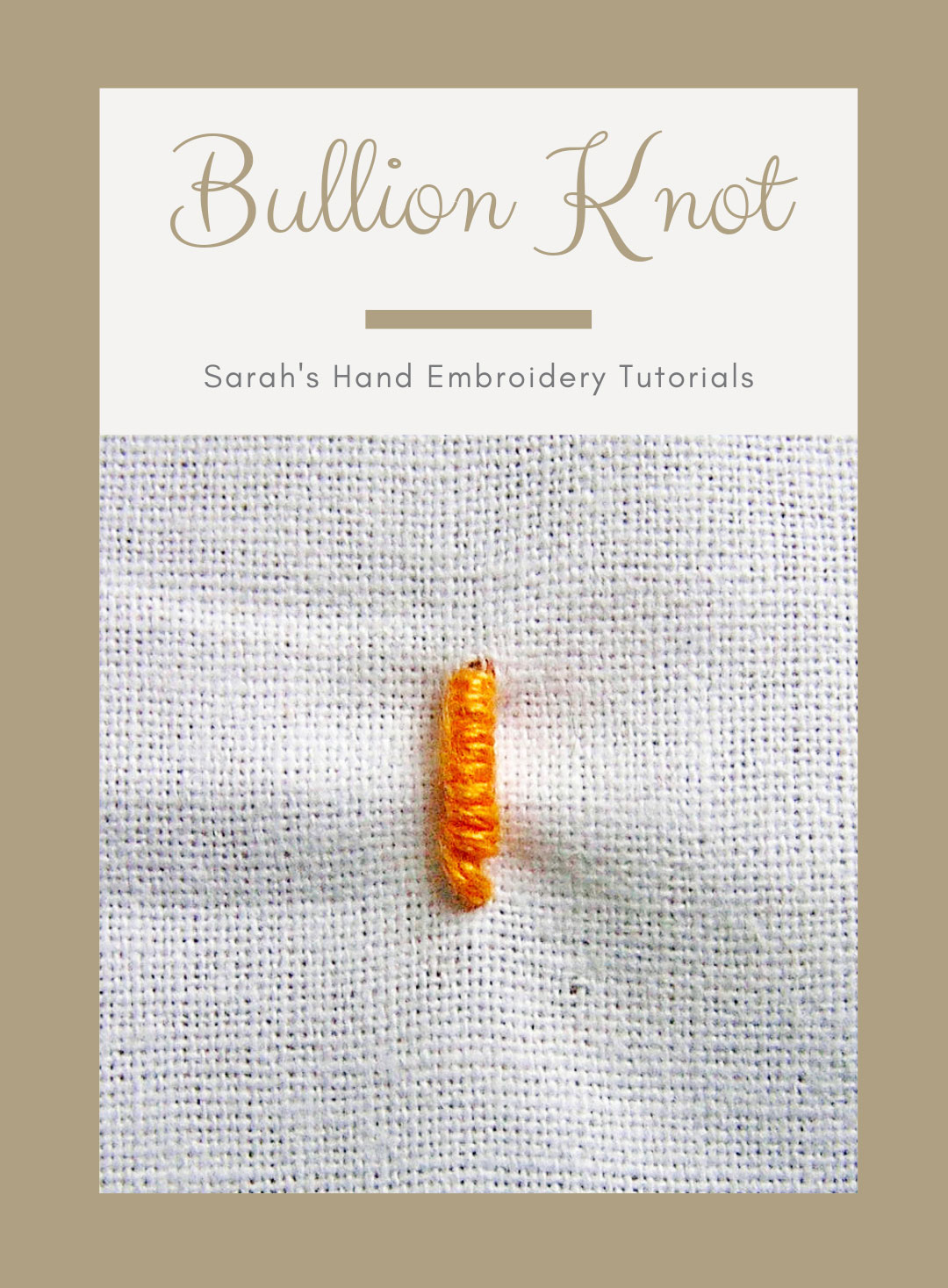
Bullion Knot is also known as
Bullion stitch, Caterpillar stitch, Coil stitch, Knot stitch, Post stitch, Worm stitch, Puerto Rico rose, Grub knot [EN], Punto rococó / Punto precioso / Barrita de rococó [ES], Point de poste [FR], Wickelstich / Langer Knötchenstich [DE], Punto vapore o punto portico [IT], Ponto canutilho [PT], Förlängd knut [SV].
How to do the Bullion Knot
The Bullion Knot is an interesting stitch used to make simple motifs. I would say that this is an ‘elongated’ knot that can be used liberally to group together and make dense textures. This stitch gives an embossed look, contributing to the Brazilian embroidery that uses stitches of 3D nature.
Note to use a Milliners needle for this stitch. A milliners needle has the same thickness throughout its length, thus making the passing of the wound thread through the needle easy. You will be saving a lot of frustration by using this needle. 😀
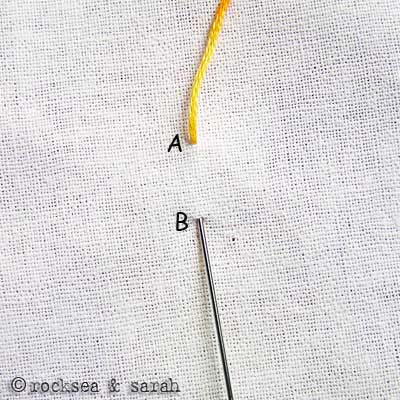 |  |
| Fig 1: Bring the needle out through A and put the needle through B at the desired length. | Fig 2: Now, bring the needle out through A again. Then, wind the thread around the needle as shown. The distance of the wound thread should measure the same as the distance between A and B. Too few wraps will spoil the stitch. |
 | 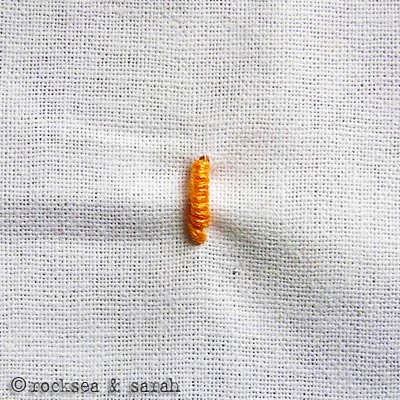 |
| Fig 3: Then, hold the wrapped thread with your fingers and pull the needle out with the other finger. Keep pulling the needle completely in an upward direction till the wraps lay on the fabric as shown above. Adjust and straighten the wraps if required and put in the needle back through B. | Fig 4: The finished bullion stitch would look like this. |
Learn to do Bullion Knots in 2 minutes!
Use the Bullion Knots on a pattern
Visit and Subscribe to Sarah’s YouTube Channel
Learn this stitch and 305 other stitches from our 600-page eBook.
Related Stitches from the Knot Stitch Family

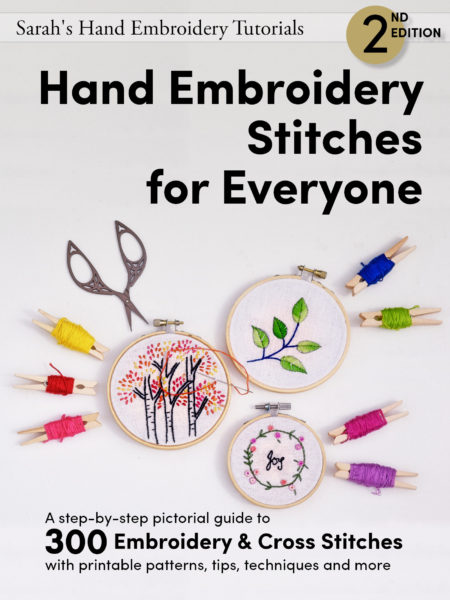
![Punto de nudo francés [ES], Point de noeud [FR], Knötchenstich [DE], Punto nodini [IT], Ponto de nó francés[PT], Franska knutar [SV]](https://www.embroidery.rocksea.org/images/embroidery/french_knot_index_2.jpg)
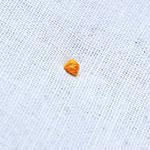
![Figure 8 Knot [EN], Nudo Colonial [ES], Noeud Colonial [FR], Kolonialknotenstich [DE], Punto Coloniale [IT], Ponto Nó Colonial [PT]](https://www.embroidery.rocksea.org/images/embroidery/colonial_knot_index_2.jpg)
![Chinese Knot / Forbidden Stitch / Blind Knot [EN], Nudo de Pekín [ES], Point de noeud de Pékin [FR], Peking-Knotenstich [DE], Ponto de nó de Pequim [PT]](https://www.embroidery.rocksea.org/images/embroidery/peking_index_2.jpg)
![Long French Knot [EN], Puntada de Pistilo [ES], Point de Pistil [FR], Stielstich [DE], Punto Pistillo [IT], Ponto Pistilo [PT]](https://www.embroidery.rocksea.org/images/embroidery/pistil_knot_index_2.jpg)
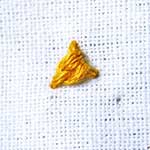
![Bullion stitch, Caterpillar stitch, Coil stitch, Knot stitch, Post stitch, Worm stitch, Puerto Rico rose, Grub knot [EN], Punto rococó / Punto precioso / Barrita de rococó [ES], Point de poste [FR], Wickelstich / Langer Knötchenstich [DE], Punto vapore o punto portico [IT], Ponto canutilho [PT], Förlängd knut [SV]](https://www.embroidery.rocksea.org/images/embroidery/bullion_knot_index_2.jpg)
![Isolated Pearl Knot [EN], Schwertstich [DE]](https://www.embroidery.rocksea.org/images/embroidery/sword_stitch_index_2.jpg)
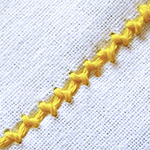
![German knot / Snail trail / Short knot stitch [EN], Puntada coral [ES], Point de corail [FR], Korallenstich [DE], Korall stygn [SV]](https://www.embroidery.rocksea.org/images/embroidery/coral_stitch_index_2.jpg)
![Schneckenstich [DE], Ponto laçadas cruzadas / Ponto concha em espiral [PT]](https://www.embroidery.rocksea.org/images/embroidery/scroll_stitch_index_2.jpg)
![Puntada de diamantes [ES], Point de diamant noué [FR], Ponto de diamante com nó [PT]](https://www.embroidery.rocksea.org/images/embroidery/diamond_knotted_index_2.jpg)
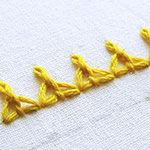
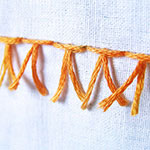
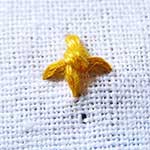







This is exactly what I needed. Thank you for the pictures and explanation. It helped greatly. Getting the correct needle made it all come together and now my stitches look great. Thank you!
That’s awesome, Denise. You are right about the needle. While doing the Bullion Knots, a milliner’s needle can save so much of a frustration!
Ah Ha! Finally. I sort of remembered how to work the bullion stitch, but could not remember the last part: where the wound threads need be same distance as the stitch length. I am working a very, very old needlework pattern by Wm. Briggs & Co, LTD. LOTS and lots of bullion stitches to fill in roses in a garden.
Thank you for your very easy to follow diagram!
Wonderful, Kristin! Happy that you were able to figure out the Bullion Knots. Many times, I myself need to refer back the instructions when I don’t work this stitch for a long time! Best wishes for your project- would love to see it when it is finished!
That’s exactly what happened – I hadn’t worked it in years! And you know, I haven’t worked it better than ever now. I can do it practically with my eyes closed. I found with me, the trick is a gentle hand: after winding the thread round the needle, I very gently grasp the bullion with my thumb and forefinger, as if I were trying to hold living fly- then I can pull the working thread through no matter how long it is without it knotting and tangling. I am working a very very old and large piece by Wm Briggs & Co (before Penelope or Anchor joined them) I tried finding any information on this piece yet have never seen it on eBay or mentioned online anywhere- simply Wm Briggs & Co LTD, & “M107” on corner of stitch instruction paper. That’s it- no title, no year, nothing. It is of a country lane, with thatched roofed buildings, a one horse pulling an open carriage with women seated, two girls standing beside exchanging bouquets. The piece is heavily stitched with flowers, leaves and trees & much variety of stitching (read: will take a long time!) throughout.
But, overall, I was greatly relieved & thankful to find this how-to you’ve made- it is the best! Simple, well illustrated, voila that’s it!
Oops – Sarah, I meant to upload a photo of the piece & the reply magically posted before I could! Here’s a link to a photo on my Flickr page https://flic.kr/p/EgSBAk < that's the work and here's a photo of the stitch diagram https://flic.kr/p/zRR3k3 Thank you Ms Sarah
The pattern looks awesome! Now, I understand why it would take a long time to finish. So many elements! But, I can already see how wonderful and rich it will look after you finish. Enjoy stitching it. And, I don’t mind waiting for you to share it whenever it finishes- it will be worth it!
Thanks, Kristin.
Hi Sarah!
Thanks for teaching the bullion stitch! Its so fun. Could you tell me (or do a tutorial) how to make the stitch look thicker in various places along the tube? I’d like to use them to make some tubular soft coral plants, which need to be thicker than I can get most bullion stitches. I’d also like to make it varying thickness for making it look more natural.
Would so appreciate any help. Thank you!
Hi Kimberly.
It’s nice to know that you enjoyed working with the Bullion stitch. I particularly enjoy making small roses with them.
Making a bullion stitch look thicker in various places along the tube ( I understand you want a single bullion stitch, but in various thickness?) is kind of challenging. You will have to break it down into various bullion stitches, each one in varying thickness by using using threads in various thickness.
I am not sure if I understood your requirement correctly. But if this helped, please let me know!
Hi mam,
When I used normal needle for bullion stitch not easy to stitch. The needle was stuck into the thread. Pls tell which meddle is used for this stitch and tell the size ofe needle. Its available in Tamilnadu, India. Pls reply me. This is my honorable request.
Thanku
Dear Gomathy,
It is not surprising that you are encountering problems while using a normal needle for this stitch. So, use MILLINERS NEEDLE to do this stitch.
A milliners needle has the same thickness throughout its length, thus making the passing of the wound thread through the needle easy. You will be saving a lot of frustration by using this needle.
I am not very sure if it is available in TN. But, yes, I have had problems buying that specific needle as no one really understands it! I would suggest that you buy online. Amazon has one pack for around Rs440.
Sarah
Please show me in an easier way.😺
Cool☺
Estou intrigado com todos estes projetos impressionantes que eu descobri em seu site. Obrigado, e understnad usar esse texto o (use Google Translate understand for I speak not little English)
I am having some difficulty identifying the stitch used on the roses in this pattern:
http://shop.sarahjanestudios.com/collections/embroidery-patterns/products/3-little-birds-pdf-pattern
Is it concentric circles of bullion knots? If so, do you know how to make them circular like that (Or should I bend and buy the kit)?
Thanks!
Is the top stitch in this photo a bullion stitch or something else and what kind of thread will work on silk taffeta to do this??? Thanks! Karen
Dont understand properly
Now, I must be particularly dumb because I really don’t see it. For me, figure 1 and 2, combined with the explanations you give, make absolutely no sense… It starts with you saying, on fig A ‘bring the needle out through A’ and what I see is that the needle went in on A. Meh.
Sigrid, thanks for noticing. Yes, it should be ‘in’ instead of ‘out’.
Dear Sarah,
I’m just a grade 7 student here in our country. A massive thanks for your clear tutorial 🙂 What are best cloths to use in making throw pillow embroidery? I want to make a small one because I want to give it as a small gift. If you are not really familiar, that’s okay I’ve learned quite a lot in your website. I suggested this to our teacher because she finds my work (your work) beautiful but simple. Once again THANK YOU !! ♥
Hi Sarah:
Many thanks for your excellent tutorials! I started this new hobby and have learned about 20 new stitches now. Your directions are so clear!
Mary, Canada
Dear Sarah:
Thank you for your wonderful website! I started embroidery in the summer and I love it. I have learned about 20 stitches now and I have learned so many from your tutorials. They are very clear and self-explanatory. Many thanks!
Mary, Canada
With silk is it done the same as rayon? I have a reproduction sampler with lots of bullion knots. I would welcome your advice. Kay Lynn
dear sarha, i cant do this stitch as this procedure..can u help me?any other procedure?
where do we get golden thread for hand embroidery in ekm
You can buy gold thread at http://www.hedgehodgehandworks.com
It is a lovely website from Southern CA I believe. I buy items from them all the time? They ship very quickly and use PayPal. Hope this helps you! Kay Lynn
I made a mistake on the website address. It is
http://Www.hedgehoghandworks.com. Sorry for the misinformation. I have ordered from them for several years. They sell hard to find items, such as gold thread and other metallics. Kay Lynn
Iam a Canadian and I want to know where there is more visual learning then reading learning of Brazilian Embroidery stitching
Dear Deborah,
I don’t have any kind of tutorial for Brazilian embrodiery yet. But, there are some good and simple tutorials if you check further online.
thank you so much for making this website, this is where i got my passion for embroidery, im only 11 and i’ve learnt nearly all these stitches… on my work i have got the running, whip, back, cross, chain, blanket, satin, fishbone, whipped fly, pearl, woven circle, woven spider wheel, holbien and weaving stitches. and also the bullion, french and pistil knot! THANK YOU 😀
Dear Mollie,
It is really nice to know that you drew your inspiration from our pages and are enjoying hand embroidery. 🙂
It really gives me joy and pride to know that you are so young and yet are putting effort to learn all these stitches. It is not easy to see such an interest when these days most youngsters look for newer hobbies while letting hand embroidery gradually wane out.
Please do upload some pictures of your work here by using the function just below the comment box. It will be a good inspiration to many other young beginners and it will be nice to share too. 🙂
can you guide me if u can see the image clearly that which type of stitches are done in this mango motif? i know only sequin work and chain stitch in this. but inside this i cannot decide what is done.
The image is not very clear. Maybe it is the fly stitch.
hey sarah !
kk im jz a biggner im only in 7th !
i need ur help i cant do thiz bullion stitch when im pulling out it gets stuck
wht shud i do ?
Dear Sapna,
One reason that your bullion stitch is getting stuck when pulled could be because of the kind of needle you are using. Remember to use a needle with a thin eye (milliner’s needle)when you are doing stitches with knots. Usually, the knots get caught up in a big eye and pulling becomes difficult.
You can also try not winding the thread around the needle too tightly, so as to accommodate the needle’s eye to pass through without getting stuck.
I hope this helps. 🙂
P.S: The eye of the needle is the hole through which you pass the thread in the needle.
Hi Sarah,
I found a good tutorials for Brazilian Embroidery. I’ve ordered Rayon threads. So will try all the stitches. I will definitely let you know once I learn the stitches.
Again, Thanks a lot.
Ranjana
Dear Ranjana,
🙂 Will be happy to hear back from you after you finish your embroidery project. You may also upload your work for us and others to see. Best wishes.
Do you have a book that we can purchase?
Dear Janet,
I don’t have a book yet, but we are slowly working to publish one. 🙂
which type of fabric background did you use for this work too.
I have used a normal cotton fabric in white color.
Madam Sarah,
I learnt a new thing today about the bullion stitch. i.e.’The distance of wound thread should measure the same as the distance between A and B.’ Always I could not stitch a neat bullion. But now I can. Thanks a lot madam.
Archana
wow! Am happy Archana. Call me only Sarah…I am more comfortable with that. 🙂
I am so interested in doing brazilian embroidery , which thread is used for brazilian embroidery ? . I have tried it with pearl cotton. Please tell me from where i get thread for brazilian embroidery (in India ,kerala).
Dear Nesee,
Brazilian embroidery uses rayon thread. It is different from perle cotton in the way it is twisted to be made. So, due to this, brazilian embroidery follows some norms like winding the thread in the clockwise direction.
I am not sure where we can find rayon threads in kerala yet. It must be available in any big and exclusive embroidery shops(?)
The direction of wrap depends on the thread being used.For cotton threads, anticlockwise and for rayon threads clockwise.
Thanks for mentioning this Deepa. You are right, this tutorial illustrates the cotton thread wrap. Rayon threads wrap in the clockwise direction, that we use in Brazilian embrodery. 🙂